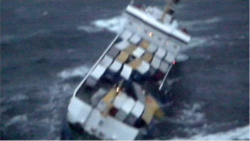Finnbirch
|
||||||||||||||
|
||||||||||||||
|
||||||||||||||
|
||||||||||||||
|
||||||||||||||
The Finnbirch was a Swedish RoRo ship , which was built as the Stena Prosper . On November 1, 2006, the ship sank in the south-east of Sweden.
The ship was built by Hyundai Heavy Industries in South Korea under hull number 646 and handed over to its owner, the Stena RoRo, on February 2, 1978. In 1988 it was sold to Finnish Rettig and seven years later to Bore Line . In 1999, Strömma Turism & Sjöfart was the last to acquire Finnbirch and its sister ship Finnforest .
The freighter is damaged
On Wednesday afternoon, November 1st, 2006, the Finnbirch got into distress on its way from Helsinki to Aarhus in the storm Britta after the cargo on board slipped in waves eight to ten meters high and the ship was listed.
The crew members had to stay on board for several hours because the Swedish rescue service considered a rescue attempt in high waves, strong winds and freezing cold with snowfall as too risky. Only when the ship sank at 7:37 p.m. between the islands of Gotland and Öland ( location ) in the Baltic Sea, which is around 70 meters deep, was the crew removed by helicopters . A total of 13 of the 14 crew members, which consisted of four Swedes and ten Filipinos , were rescued. They had broken bones and skulls, had hypothermia and were in shock. A seaman later died of his injuries in Kalmar hospital .
At the time of the sinking, the ship had bunkered around 250 tons of heavy fuel oil and ten tons of lubricating oil. It was not possible to fight oil due to the storm.
After the accident, there was criticism of the Swedish sea rescue, which had to prove itself for the first time after the split from the Air Force. The reason for the criticism was the long hesitation to rescue and the new helicopters of the sea rescue. They are smaller than those of the Air Force, have to refuel more often and in total only five of these helicopters are available for the entire sea rescue service.
